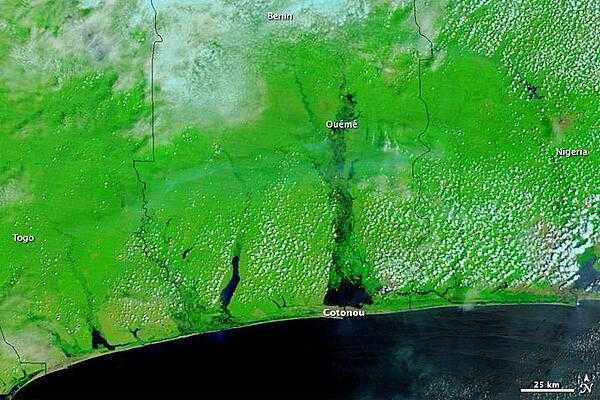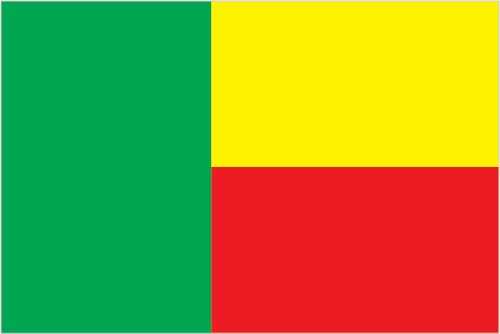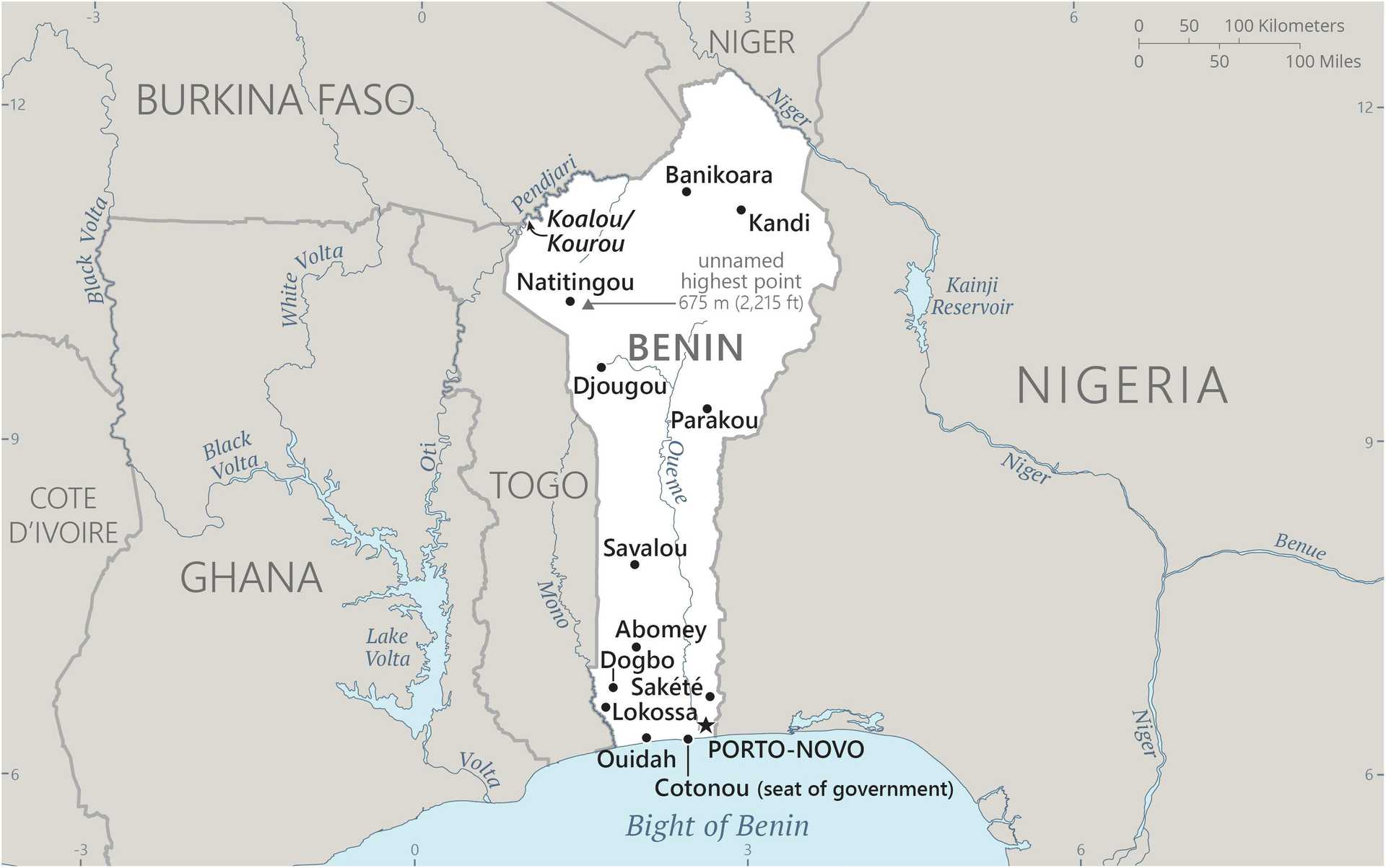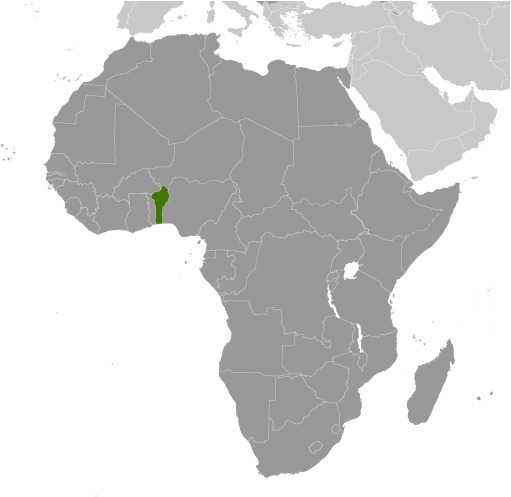Introduction
Background
Present-day Benin is comprised of about 42 ethnic groups, including the Yoruba in the southeast, who migrated from what is now Nigeria in the 12th century; the Dendi in the north-central area, who came from Mali in the 16th century; the Bariba and the Fula in the northeast; the Ottamari in the Atakora mountains; the Fon in the area around Abomey in the south-central area; and the Mina, Xueda, and Aja, who came from Togo, on the coast. The Kingdom of Dahomey emerged on the Abomey plateau in the 17th century and was a regional power for much of the 18th and 19th centuries. The growth of Dahomey coincided with the growth of the Atlantic slave trade, and it became known as a major source of enslaved people. France began to control the coastal areas of Dahomey in the second half of the 19th century; the entire kingdom was conquered by 1894. French Dahomey achieved independence in 1960, and it changed its name to the Republic of Benin in 1975.
A succession of military governments ended in 1972 with the rise to power of Mathieu KEREKOU and a Marxist-Leninist government. A move to representative government began in 1989. Two years later, free elections ushered in former Prime Minister Nicephore SOGLO as president, marking the first successful transfer of power in Africa from a dictatorship to a democracy. KEREKOU returned to power after elections in 1996 and 2001. He stepped down in 2006 and was succeeded by Thomas YAYI Boni, a political outsider and independent, who won a second term in 2011. Patrice TALON, a wealthy businessman, took office in 2016; the space for pluralism, dissent, and free expression has narrowed under his administration. TALON won a second term in 2021.
Visit the Definitions and Notes page to view a description of each topic.
Geography
Location
Western Africa, bordering the Bight of Benin, between Nigeria and Togo
Geographic coordinates
9 30 N, 2 15 E
Map references
Africa
Area - comparative
slightly smaller than Pennsylvania
Land boundaries
total: 2,123 km
border countries (4): Burkina Faso 386 km; Niger 277 km; Nigeria 809 km; Togo 651 km
Coastline
121 km
Maritime claims
territorial sea: 200 nm; note: the US does not recognize this claim
continental shelf: 200 nm
exclusive fishing zone: 200 nm
Climate
tropical; hot, humid in south; semiarid in north
Terrain
mostly flat to undulating plain; some hills and low mountains
Elevation
highest point: unnamed elevation 675 m; located 2.5 km southeast of the town of Kotopounga
lowest point: Atlantic Ocean 0 m
mean elevation: 273 m
Natural resources
small offshore oil deposits, limestone, marble, timber
Land use
agricultural land: 31.3% (2018 est.)
arable land: 22.9% (2018 est.)
permanent crops: 3.5% (2018 est.)
permanent pasture: 4.9% (2018 est.)
forest: 40% (2018 est.)
other: 28.7% (2018 est.)
Irrigated land
172 sq km (2017)
Major watersheds (area sq km)
Atlantic Ocean drainage: Niger (2,261,741 sq km), Volta (410,991 sq km)
Population distribution
the population is primarily located in the south, with the highest concentration of people residing in and around the cities on the Atlantic coast; most of the north remains sparsely populated with higher concentrations of residents in the west as shown in this population distribution map
Natural hazards
hot, dry, dusty harmattan wind may affect north from December to March
Geography - note
sandbanks create difficult access to a coast with no natural harbors, river mouths, or islands
People and Society
Population
total: 14,697,052
male: 7,253,258
female: 7,443,794 (2024 est.)
comparison rankings: female 74; male 74; total 74
Nationality
noun: Beninese (singular and plural)
adjective: Beninese
Ethnic groups
Fon and related 38.4%, Adja and related 15.1%, Yoruba and related 12%, Bariba and related 9.6%, Fulani and related 8.6%, Ottamari and related 6.1%, Yoa-Lokpa and related 4.3%, Dendi and related 2.9%, other 0.9%, foreigner 1.9% (2013 est.)
Languages
55 languages; French (official); Fon (a Gbe language), Yom (a Gur language) and Yoruba are the most important indigenous languages in the south; half a dozen regionally important languages in the north, including Bariba (once counted as a Gur language) and Fulfulde
Religions
Muslim 27.7%, Roman Catholic 25.5%, Protestant 13.5% (Celestial 6.7%, Methodist 3.4%, other Protestant 3.4%), Vodoun 11.6%, other Christian 9.5%, other traditional religions 2.6%, other 2.6%, none 5.8% (2013 est.)
Demographic profile
Benin has a youthful age structure – almost 65% of the population is under the age of 25 as of 2022 – which is bolstered by high fertility and population growth rates. Benin’s total fertility has been falling over time but remains high, declining from almost 7 children per women in 1990 to 5.4 in 2022. Benin’s low contraceptive use and high unmet need for contraception contribute to the sustained high fertility rate. Although the majority of Beninese women use skilled health care personnel for antenatal care and delivery, the high rate of maternal mortality indicates the need for more access to high quality obstetric care.
Poverty, unemployment, increased living costs, and dwindling resources increasingly drive the Beninese to migrate. An estimated 4.4 million, more than 30%, of Beninese live abroad. Virtually all Beninese emigrants move to West African countries, particularly Nigeria and Cote d’Ivoire. Of the less than 1% of Beninese emigrants who settle in Europe, the vast majority live in France, Benin’s former colonial ruler.
With about 40% of the population living below the poverty line as of 2019, many desperate parents resort to sending their children to work in wealthy households as domestic servants (a common practice known as vidomegon), mines, quarries, or agriculture domestically or in Nigeria and other neighboring countries, often under brutal conditions. Unlike in other West African countries, where rural people move to the coast, farmers from Benin’s densely populated southern and northwestern regions move to the historically sparsely populated central region to pursue agriculture. Immigrants from West African countries came to Benin in increasing numbers between 1992 and 2002 because of its political stability and porous borders.
Age structure
0-14 years: 45.3% (male 3,360,027/female 3,294,201)
15-64 years: 52.2% (male 3,727,040/female 3,951,786)
65 years and over: 2.5% (2024 est.) (male 166,191/female 197,807)
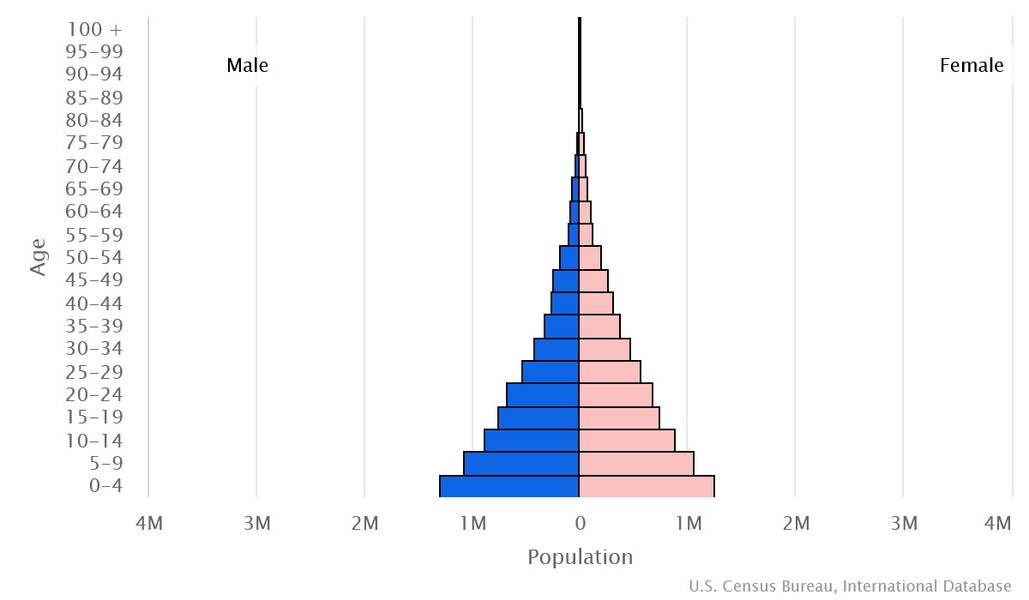
Dependency ratios
total dependency ratio: 84
youth dependency ratio: 78.3
elderly dependency ratio: 5.7
potential support ratio: 17.7 (2021 est.)
Median age
total: 17.2 years (2024 est.)
male: 16.6 years
female: 17.7 years
comparison ranking: total 223
Population distribution
the population is primarily located in the south, with the highest concentration of people residing in and around the cities on the Atlantic coast; most of the north remains sparsely populated with higher concentrations of residents in the west as shown in this population distribution map
Urbanization
urban population: 50.1% of total population (2023)
rate of urbanization: 3.74% annual rate of change (2020-25 est.)
Major urban areas - population
285,000 PORTO-NOVO (capital) (2018); 1.253 million Abomey-Calavi, 722,000 COTONOU (seat of government) (2022)
Sex ratio
at birth: 1.05 male(s)/female
0-14 years: 1.02 male(s)/female
15-64 years: 0.94 male(s)/female
65 years and over: 0.84 male(s)/female
total population: 0.97 male(s)/female (2024 est.)
Mother's mean age at first birth
20.5 years (2017/18 est.)
note: data represents median age at first birth among women 25-49
Infant mortality rate
total: 52.9 deaths/1,000 live births (2024 est.)
male: 57.8 deaths/1,000 live births
female: 47.8 deaths/1,000 live births
comparison ranking: total 16
Life expectancy at birth
total population: 63 years (2024 est.)
male: 61.1 years
female: 65 years
comparison ranking: total population 213
Gross reproduction rate
2.61 (2024 est.)
Contraceptive prevalence rate
15.5% (2017/18)
Drinking water source
improved: urban: 79% of population
rural: 70.8% of population
total: 74.7% of population
unimproved: urban: 21% of population
rural: 29.2% of population
total: 25.3% of population (2020 est.)
Current health expenditure
2.6% of GDP (2020)
Physicians density
0.07 physicians/1,000 population (2019)
Hospital bed density
0.5 beds/1,000 population
Sanitation facility access
improved: urban: 56.3% of population
rural: 18.1% of population
total: 36.6% of population
unimproved: urban: 43.7% of population
rural: 81.9% of population
total: 63.4% of population (2020 est.)
Major infectious diseases
degree of risk: very high (2023)
food or waterborne diseases: bacterial and protozoal diarrhea, hepatitis A, and typhoid fever
vectorborne diseases: dengue fever, malaria, sexually transmitted diseases: hepatitis B (2024)
animal contact diseases: rabies
respiratory diseases: meningococcal meningitis
note: on 31 August 2023, the US Centers for Disease Control and Prevention (CDC) issued a Travel Alert for polio in Africa; Benin is currently considered a high risk to travelers for circulating vaccine-derived polioviruses (cVDPV); vaccine-derived poliovirus (VDPV) is a strain of the weakened poliovirus that was initially included in oral polio vaccine (OPV) and that has changed over time and behaves more like the wild or naturally occurring virus; this means it can be spread more easily to people who are unvaccinated against polio and who come in contact with the stool or respiratory secretions, such as from a sneeze, of an “infected” person who received oral polio vaccine; the CDC recommends that before any international travel, anyone unvaccinated, incompletely vaccinated, or with an unknown polio vaccination status should complete the routine polio vaccine series; before travel to any high-risk destination, the CDC recommends that adults who previously completed the full, routine polio vaccine series receive a single, lifetime booster dose of polio vaccine
Alcohol consumption per capita
total: 1.25 liters of pure alcohol (2019 est.)
beer: 0.81 liters of pure alcohol (2019 est.)
wine: 0.02 liters of pure alcohol (2019 est.)
spirits: 0.2 liters of pure alcohol (2019 est.)
other alcohols: 0.22 liters of pure alcohol (2019 est.)
comparison ranking: total 145
Tobacco use
total: 6.9% (2020 est.)
male: 11.8% (2020 est.)
female: 1.9% (2020 est.)
comparison ranking: total 157
Currently married women (ages 15-49)
68.3% (2023 est.)
Child marriage
women married by age 15: 9.4%
women married by age 18: 30.6%
men married by age 18: 4.8% (2018 est.)
Literacy
definition: age 15 and over can read and write
total population: 45.8%
male: 56.9%
female: 35% (2021)
School life expectancy (primary to tertiary education)
total: 11 years
male: 12 years
female: 10 years (2020)
Environment
Environment - current issues
inadequate supplies of potable water; water pollution; poaching threatens wildlife populations; deforestation; desertification (the spread of the desert into agricultural lands in the north is accelerated by regular droughts)
Environment - international agreements
party to: Biodiversity, Climate Change, Climate Change-Kyoto Protocol, Climate Change-Paris Agreement, Comprehensive Nuclear Test Ban, Desertification, Endangered Species, Environmental Modification, Hazardous Wastes, Law of the Sea, Marine Dumping-London Convention, Nuclear Test Ban, Ozone Layer Protection, Ship Pollution, Tropical Timber 2006, Wetlands, Whaling
signed, but not ratified: none of the selected agreements
Climate
tropical; hot, humid in south; semiarid in north
Land use
agricultural land: 31.3% (2018 est.)
arable land: 22.9% (2018 est.)
permanent crops: 3.5% (2018 est.)
permanent pasture: 4.9% (2018 est.)
forest: 40% (2018 est.)
other: 28.7% (2018 est.)
Urbanization
urban population: 50.1% of total population (2023)
rate of urbanization: 3.74% annual rate of change (2020-25 est.)
Air pollutants
particulate matter emissions: 31.51 micrograms per cubic meter (2019 est.)
carbon dioxide emissions: 6.48 megatons (2016 est.)
methane emissions: 5.8 megatons (2020 est.)
Waste and recycling
municipal solid waste generated annually: 685,936 tons (1993 est.)
municipal solid waste recycled annually: 171,484 tons (2005 est.)
percent of municipal solid waste recycled: 25% (2005 est.)
Major watersheds (area sq km)
Atlantic Ocean drainage: Niger (2,261,741 sq km), Volta (410,991 sq km)
Total water withdrawal
municipal: 150 million cubic meters (2020 est.)
industrial: 30 million cubic meters (2020 est.)
agricultural: 60 million cubic meters (2020 est.)
Total renewable water resources
26.39 billion cubic meters (2020 est.)
Government
Country name
conventional long form: Republic of Benin
conventional short form: Benin
local long form: Republique du Benin
local short form: Benin
former: Dahomey, People's Republic of Benin
etymology: named for the Bight of Benin, the body of water on which the country lies
Government type
presidential republic
Capital
name: Porto-Novo (constitutional capital); Cotonou (seat of government)
geographic coordinates: 6 29 N, 2 37 E
time difference: UTC+1 (6 hours ahead of Washington, DC, during Standard Time)
etymology: the name Porto-Novo is Portuguese for "new port"; Cotonou means "by the river of death" in the native Fon language
Administrative divisions
12 departments; Alibori, Atacora, Atlantique, Borgou, Collines, Couffo, Donga, Littoral, Mono, Oueme, Plateau, Zou
Independence
1 August 1960 (from France)
National holiday
Independence Day, 1 August (1960)
Constitution
history: previous 1946, 1958 (preindependence); latest adopted by referendum 2 December 1990, promulgated 11 December 1990
amendments: proposed concurrently by the president of the republic (after a decision in the Council of Ministers) and the National Assembly; consideration of drafts or proposals requires at least three-fourths majority vote of the Assembly membership; passage requires approval in a referendum unless approved by at least four-fifths majority vote of the Assembly membership; constitutional articles affecting territorial sovereignty, the republican form of government, and secularity of Benin cannot be amended; amended 2019
Legal system
civil law system modeled largely on the French system and some customary law
International law organization participation
has not submitted an ICJ jurisdiction declaration; accepts ICCt jurisdiction
Citizenship
citizenship by birth: no
citizenship by descent only: at least one parent must be a citizen of Benin
dual citizenship recognized: yes
residency requirement for naturalization: 10 years
Suffrage
18 years of age; universal
Executive branch
chief of state: President Patrice TALON (since 6 April 2016); note - the president is both head of state and head of government
head of government: President Patrice TALON (since 6 April 2016); prime minister position abolished
cabinet: Council of Ministers appointed by the president
elections/appointments: president directly elected by absolute majority popular vote in 2 rounds if needed for a 5-year term (eligible for a second term); last held on 11 April 2021 (next to be held on 12 April 2026)
election results:
2021: Patrice TALON reelected president in the ; percent of vote - Patrice TALON (independent) 86.3%, Alassane SOUMANOU (FCBE) 11.4%, Corentin KOHOUE (The Democrats) 2.3%
2016: Patrice TALON elected president in second round; percent of vote in first round - Lionel ZINSOU (FCBE) 28.4%, Patrice TALON (independent) 24.8%, Sebastien AJAVON (independent) 23%, Abdoulaye Bio TCHANE (ABT) 8.8%, Pascal KOUPAKI (NC) 5.9%, other 9.1%; percent of vote in second round - Patrice TALON 65.4%, Lionel ZINSOU 34.6%
Legislative branch
description: unicameral National Assembly or Assemblee Nationale (109 seats, including 24 seats reserved for women; members directly elected in multi-seat constituencies by party-list proportional representation vote; members serve 5-year terms except for the current members whose terms will end in 2026 to facilitate general elections)
elections: last held on 8 January 2023 (next to be held on 11 January 2027)
election results: percent of vote by party - Progressive Union for Renewal 37.6%, Bloc Republicain 29.2%, The Democrats 24%; seats by party - Progressive Union for Renewal 53, Bloc Republicain 28, The Democrats 28; composition- men 80, women 29, percentage women 26.6%
Judicial branch
highest court(s): Supreme Court or Cour Supreme (consists of the chief justice and 16 justices organized into an administrative division, judicial chamber, and chamber of accounts); Constitutional Court or Cour Constitutionnelle (consists of 7 members, including the court president); High Court of Justice (consists of the Constitutional Court members, 6 members appointed by the National Assembly, and the Supreme Court president); note - jurisdiction of the High Court of Justice is limited to cases of high treason by the national president or members of the government while in office
judge selection and term of office: Supreme Court president and judges appointed by the president of the republic upon the advice of the National Assembly; judges appointed for single renewable 5-year terms; Constitutional Court members - 4 appointed by the National Assembly and 3 by the president of the republic; members appointed for single renewable 5-year terms; other members of the High Court of Justice elected by the National Assembly; member tenure NA
subordinate courts: Court of Appeal or Cour d'Appel; Court for the Repression of Economic and Terrorism Infractions (CRIET) or Cour de Repression des Infractions Economiques et du Terrorisme; district courts; village courts; Assize courts
Political parties and leaders
African Movement for Development and Progress or MADEP [Sefou FAGBOHOUN]
Benin Renaissance or RB [Lehady SOGLO]
Cowrie Force for an Emerging Benin or FCBE [Thomas Boni YAYI]
Democratic Renewal Party or PRD [Adrien HOUNGBEDJI]
Progressive Union for Renewal [Joseph DJOGBENOU]
Republican Bloc [Abdoulaye BIO TCHANE]
Sun Alliance or AS [Sacca LAFIA]
The Democrats [Boni YAY]
Union Makes the Nation or UN [Adrien HOUNGBEDJI] (includes PRD, MADEP)
note: approximately 20 additional minor parties
International organization participation
ACP, AfDB, AU, CD, ECOWAS, Entente, FAO, FZ, G-77, IAEA, IBRD, ICAO, ICCt, ICRM, IDA, IDB, IFAD, IFC, IFRCS, ILO, IMF, IMO, Interpol, IOC, IOM, IPU, ISO, ITSO, ITU, ITUC (NGOs), MIGA, MNJTF, MONUSCO, NAM, OAS (observer), OIC, OIF, OPCW, PCA, UN, UNAMID, UNCTAD, UNESCO, UNHCR, UNHRC, UNIDO, UNISFA, UNMIL, UNMISS, UNOCI, UNOOSA, UNWTO, UPU, WADB (regional), WAEMU, WCO, WFTU (NGOs), WHO, WIPO, WMO, WTO
Diplomatic representation in the US
chief of mission: Ambassador Jean-Claude Felix DO REGO (since 17 July 2020)
chancery: 2124 Kalorama Road NW, Washington, DC 20008
telephone: [1] (202) 232-6656; [1] (202) 232-2611
FAX: [1] (202) 265-1996
email address and website:
ambassade.washington@gouv.bj
https://beninembassy.us/
Diplomatic representation from the US
chief of mission: Ambassador Brian SHUKAN (since 5 May 2022)
embassy: 01 BP 2012, Cotonou
mailing address:
2120 Cotonou Place, Washington DC 20521-2120
telephone: [229] 21-30-06-50
FAX: [229] 21-30-03-84
email address and website:
ACSCotonou@state.gov
https://bj.usembassy.gov/
Flag description
two equal horizontal bands of yellow (top) and red (bottom) with a vertical green band on the hoist side; green symbolizes hope and revival, yellow wealth, and red courage
note: uses the popular Pan-African colors of Ethiopia
National symbol(s)
leopard; national colors: green, yellow, red
National anthem
name: "L'Aube Nouvelle" (The Dawn of a New Day)
lyrics/music: Gilbert Jean DAGNON
note: adopted 1960
National heritage
total World Heritage Sites: 2 (1 cultural, 1 natural)
selected World Heritage Site locales: Royal Palaces of Abomey (c); W-Arly-Pendjari Complex (n)
Economy
Economic overview
robust economic growth; slightly declining but still widespread poverty; strong trade relations with Nigeria; cotton exporter; COVID-19 has led to capital outflows and border closures; WAEMU member with currency pegged to the euro; recent fiscal deficit and debt reductions
Real GDP (purchasing power parity)
$45.869 billion (2022 est.)
$43.17 billion (2021 est.)
$40.287 billion (2020 est.)
note: data in 2017 dollars
comparison ranking: 117
Real GDP growth rate
6.25% (2022 est.)
7.16% (2021 est.)
3.85% (2020 est.)
note: annual GDP % growth based on constant local currency
comparison ranking: 54
Real GDP per capita
$3,400 (2022 est.)
$3,300 (2021 est.)
$3,200 (2020 est.)
note: data in 2017 dollars
comparison ranking: 187
GDP (official exchange rate)
$17.397 billion (2022 est.)
note: data in current dollars at official exchange rate
Inflation rate (consumer prices)
1.35% (2022 est.)
1.73% (2021 est.)
3.02% (2020 est.)
note: annual % change based on consumer prices
comparison ranking: 21
Credit ratings
Fitch rating: B (2019)
Moody's rating: B2 (2019)
Standard & Poors rating: B+ (2018)
note: The year refers to the year in which the current credit rating was first obtained.
GDP - composition, by sector of origin
agriculture: 26.1% (2017 est.)
industry: 22.8% (2017 est.)
services: 51.1% (2017 est.)
comparison rankings: services 174; industry 125; agriculture 27
GDP - composition, by end use
household consumption: 70.5% (2017 est.)
government consumption: 13.1% (2017 est.)
investment in fixed capital: 27.6% (2017 est.)
investment in inventories: 0% (2017 est.)
exports of goods and services: 31.6% (2017 est.)
imports of goods and services: -43% (2017 est.)
Agricultural products
cassava, yams, maize, oil palm fruit, cotton, rice, pineapples, soybeans, tomatoes, vegetables (2022)
note: top ten agricultural products based on tonnage
Industries
textiles, food processing, construction materials, cement
Industrial production growth rate
7.89% (2022 est.)
note: annual % change in industrial value added based on constant local currency
comparison ranking: 29
Labor force
4.797 million (2022 est.)
note: number of people ages 15 or older who are employed or seeking work
comparison ranking: 89
Unemployment rate
1.48% (2022 est.)
1.78% (2021 est.)
1.62% (2020 est.)
note: % of labor force seeking employment
comparison ranking: 13
Youth unemployment rate (ages 15-24)
total: 3.9% (2021 est.)
male: 3.1%
female: 4.6%
comparison ranking: total 193
Population below poverty line
38.5% (2018 est.)
note: % of population with income below national poverty line
Gini Index coefficient - distribution of family income
37.9 (2018 est.)
note: index (0-100) of income distribution; higher values represent greater inequality
comparison ranking: 73
Household income or consumption by percentage share
lowest 10%: 2.9%
highest 10%: 30% (2018 est.)
note: % share of income accruing to lowest and highest 10% of population
Remittances
1.33% of GDP (2022 est.)
1.31% of GDP (2021 est.)
1.3% of GDP (2020 est.)
note: personal transfers and compensation between resident and non-resident individuals/households/entities
Budget
revenues: $2.024 billion (2019 est.)
expenditures: $2.101 billion (2019 est.)
Fiscal year
calendar year
Current account balance
-$734.659 million (2021 est.)
-$273.967 million (2020 est.)
-$575.593 million (2019 est.)
note: balance of payments - net trade and primary/secondary income in current dollars
comparison ranking: 114
Exports
$4.154 billion (2021 est.)
$3.506 billion (2020 est.)
$3.585 billion (2019 est.)
note: balance of payments - exports of goods and services in current dollars
comparison ranking: 143
Exports - partners
India 27%, Bangladesh 24%, UAE 23%, China 4%, Egypt 2% (2022)
note: top five export partners based on percentage share of exports
Exports - commodities
cotton, gold, coconuts/Brazil nuts/cashews, soybeans, oil seeds (2022)
note: top five export commodities based on value in dollars
Imports
$4.925 billion (2021 est.)
$3.942 billion (2020 est.)
$4.307 billion (2019 est.)
note: balance of payments - imports of goods and services in current dollars
comparison ranking: 152
Imports - partners
China 24%, India 14%, US 6%, UAE 6%, France 5% (2022)
note: top five import partners based on percentage share of imports
Imports - commodities
rice, refined petroleum, palm oil, cars, poultry (2022)
note: top five import commodities based on value in dollars
Reserves of foreign exchange and gold
$698.9 million (31 December 2017 est.)
$57.5 million (31 December 2016 est.)
comparison ranking: 149
Debt - external
$2.804 billion (31 December 2017 est.)
$2.476 billion (31 December 2016 est.)
comparison ranking: 145
Exchange rates
Communaute Financiere Africaine francs (XOF) per US dollar -
Exchange rates:
623.937 (2022 est.)
554.608 (2021 est.)
574.295 (2020 est.)
585.951 (2019 est.)
555.446 (2018 est.)
Energy
Electricity access
population without electricity: 8 million (2020)
electrification - total population: 41.9% (2021)
electrification - urban areas: 66.9% (2021)
electrification - rural areas: 17.9% (2021)
Electricity
installed generating capacity: 475,000 kW (2020 est.)
consumption: 524.08 million kWh (2020 est.)
exports: 2 million kWh (2020 est.)
imports: 646 million kWh (2020 est.)
transmission/distribution losses: 346 million kWh (2020 est.)
comparison rankings: transmission/distribution losses 76; imports 81; exports 98; consumption 171; installed generating capacity 152
Electricity generation sources
fossil fuels: 96.9% of total installed capacity (2020 est.)
nuclear: 0% of total installed capacity (2020 est.)
solar: 3.1% of total installed capacity (2020 est.)
wind: 0% of total installed capacity (2020 est.)
hydroelectricity: 0% of total installed capacity (2020 est.)
tide and wave: 0% of total installed capacity (2020 est.)
geothermal: 0% of total installed capacity (2020 est.)
biomass and waste: 0% of total installed capacity (2020 est.)
Coal
production: 0 metric tons (2020 est.)
consumption: 78,000 metric tons (2020 est.)
exports: 0 metric tons (2020 est.)
imports: 78,000 metric tons (2020 est.)
proven reserves: 0 metric tons (2019 est.)
Petroleum
total petroleum production: 0 bbl/day (2021 est.)
refined petroleum consumption: 46,300 bbl/day (2019 est.)
crude oil and lease condensate exports: 0 bbl/day (2018 est.)
crude oil and lease condensate imports: 0 bbl/day (2018 est.)
crude oil estimated reserves: 8 million barrels (2021 est.)
Natural gas
production: 0 cubic meters (2021 est.)
consumption: 19.057 million cubic meters (2019 est.)
exports: 0 cubic meters (2021 est.)
imports: 19.057 million cubic meters (2019 est.)
proven reserves: 1.133 billion cubic meters (2021 est.)
Carbon dioxide emissions
6.903 million metric tonnes of CO2 (2019 est.)
from coal and metallurgical coke: 274,000 metric tonnes of CO2 (2019 est.)
from petroleum and other liquids: 6.592 million metric tonnes of CO2 (2019 est.)
from consumed natural gas: 37,000 metric tonnes of CO2 (2019 est.)
comparison ranking: total emissions 126
Communications
Telephones - fixed lines
total subscriptions: 1,526 (2022 est.)
subscriptions per 100 inhabitants: (2021 est.) less than 1
comparison ranking: total subscriptions 218
Telephones - mobile cellular
total subscriptions: 12,731,782 (2021 est.)
subscriptions per 100 inhabitants: 98 (2021 est.)
comparison ranking: total subscriptions 78
Telecommunication systems
general assessment: Benin’s telecom market continues to be restricted by the poor condition of the country’s fixed-line infrastructure; this has hampered the development of fixed-line voice and internet services, and there is negligible revenue derived from these sectors; mobile networks account for almost all internet connections, and also carry most voice traffic; there is promise for considerable change in the mobile sector; slow progress is being made in developing competition in the mobile sector; in May 2021 the government sought foreign companies to bid for a fourth mobile license; improved international internet connectivity has contributed to a reduction in end-user pricing, and provided the potential to transform many areas of the country’s economy, bringing a greater proportion of the population into the orbit of internet commerce and connectivity; a 2,000km fiber project started in 2016 was finally completed in mid-2021, prompting the government to secure a loan to build additional fiber infrastructure connecting four of the country’s 12 departments (2022)
domestic: fixed-line teledensity less than 1 per 100 people; mobile cellular subscriptions are 98 per 100 people (2021)
international: country code - 229; landing points for the SAT-3/WASC and ACE fiber-optic submarine cable that provides connectivity to Europe, and most West African countries; satellite earth stations - 7 (Intelsat-Atlantic Ocean) (2019)
Broadcast media
state-run Office de Radiodiffusion et de Television du Benin (ORTB) operates a TV station providing a wide broadcast reach; several privately owned TV stations broadcast from Cotonou; satellite TV subscription service is available; state-owned radio, under ORTB control, includes a national station supplemented by a number of regional stations; substantial number of privately owned radio broadcast stations; transmissions of a few international broadcasters are available on FM in Cotonou (2019)
Internet users
total: 4.42 million (2021 est.)
percent of population: 34% (2021 est.)
comparison ranking: total 104
Broadband - fixed subscriptions
total: 29,981 (2020 est.)
subscriptions per 100 inhabitants: 0.3 (2020 est.)
comparison ranking: total 155
Transportation
National air transport system
number of registered air carriers: 1 (2015)
inventory of registered aircraft operated by air carriers: 1 (2015)
annual passenger traffic on registered air carriers: 112,392 (2015)
annual freight traffic on registered air carriers: 805,347 (2015) mt-km
Pipelines
134 km gas
Waterways
150 km (2011) (seasonal navigation on River Niger along northern border)
comparison ranking: 111
Ports and terminals
major seaport(s): Cotonou
LNG terminal(s) (import): Cotonou
Military and Security
Military and security forces
Beninese Armed Forces (Forces Armees Beninoises, FAB; aka Benin Defense Forces): Army, Navy, Air Force, National Guard (aka Republican Guard)
Ministry of Interior and Public Security: Republican Police (Police Republicaine, DGPR) (2023)
note: FAB is under the Ministry of Defense and is responsible for external security and supporting the DGPR in maintaining internal security, which has primary responsibility for enforcing law and maintaining order; the DGPR was formed in 2018 through a merger of police and gendarmes
Military expenditures
0.7% of GDP (2022 est.)
0.7% of GDP (2021 est.)
0.5% of GDP (2020 est.)
0.5% of GDP (2019 est.)
0.7% of GDP (2018 est.)
comparison ranking: 142
Military and security service personnel strengths
approximately 12,000 active-duty troops, including about 3,000 National Guard; estimated 5,000 Republican Police (2023)
Military equipment inventories and acquisitions
the FAB is equipped with a small mix of mostly older or secondhand French, Soviet-era, and US equipment; in recent years, France has provided it with limited amounts of newer military hardware such as armored vehicles and helicopters (2023)
Military service age and obligation
18-35 years of age for voluntary and selective compulsory military service for men and women; a higher education diploma is required; conscript service is 18 months (2023)
Military - note
a key focus for the security forces of Benin is countering infiltrations into the country by terrorist groups tied to al-Qa'ida and the Islamic State of Iraq and ash-Sham (ISIS) operating just over the border from northern Benin in Burkina Faso and Niger; in May 2022, the Benin Government said it was "at war" after suffering a series of attacks from these groups; later that same year, President TALON said his government would spend more than $130 million to recruit up to 4,000 additional military personnel, modernize military equipment, and build and fortify operating bases; in addition, the FAB participates in the Multinational Joint Task Force (MNJTF) along with Cameroon, Chad, Niger, and Nigeria against Boko Haram and ISIS-West Africa in the general area of the Lake Chad Basin and along Nigeria's northeastern border
the FAB has a close working relationship with the Belgian armed forces; the Belgians offer military advice, training, and second-hand equipment donations, and deploy to Benin for limited military exercises (2023)
Terrorism
Terrorist group(s)
Terrorist group(s): al-Qa’ida (Jama’at Nusrat al Islam wal Muslimeen); Islamic State in the Greater Sahara (ISIS-GS); Boko Haram
note: details about the history, aims, leadership, organization, areas of operation, tactics, targets, weapons, size, and sources of support of the group(s) appear(s) in Appendix-T
Transnational Issues
Illicit drugs
a significant transit and departure country for cocaine shipments in Africa destined for Europe
